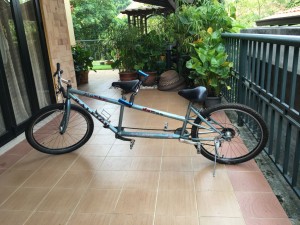What is a tandem bicycle?
The tandem bicycle or twin is a form of bicycle (occasionally, a tricycle) designed to be ridden by more than one person. The term tandem refers to the seating arrangement (fore to aft, not side by side), not the number of riders. A bike with two riders side by side is called a sociable.
Riding Techniques
The rear rider starts clipped in while the front rider holds the tandem upright. For those who can get accustomed to the rear rider always being clipped in, the distinct advantage to this technique will become obvious when trying to start at the foot of a bridge or on a hill. If the tandem team does not practice this, then they often reserve this type of start for when they are faced with a bridge or hill. This technique allows the rear rider to apply continuous power as the front rider steadies the tandem during the initial take-off. This reduces the risk of the tandem toppling over due to starting on an incline. The rear rider will continue to pedal as the front rider attempts to get the foot used for steadying the tandem clipped into the pedal.
Crank Phase
Riders may choose to synchronise their pedalling through in-phase (IP) or out-of-phase (OOP) pedalling. In in-phase pedalling, each rider’s cranks are the same or opposite clock positions at any point in time. In out-of-phase pedalling, both riders have their cranks in differing non-opposite positions. This has the potential for a wide range of variation. Some tandem riders arrange their cranks so that they are 90° out of phase to produce what is called the “4 banger arrangement”. In practice, OOP setups range from a mere two-tooth phase difference between cranks to a full 90° phase difference. Generally, OOP provides the greatest benefits to the tandem team that has disparate leg-strength.[citation needed] When the tandem is pedalled IP it is possible, and often happens, that the stronger rider literally drops the pedals out from beneath the feet of the weaker rider and cause the latter to be unable to contribute meaningfully. Using OOP makes a significant difference in gearing choice as each rider has the full mass of the tandem in their power stroke, so lower gears are preferred. However, using OOP can help develop leg strength for the very same reason. Some argue that this produces a smoother power stroke, or that it reduces stress on the drive train because the point of maximum power is reduced to roughly half and distributed over the chainrings. [15] [16]
